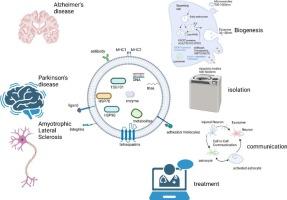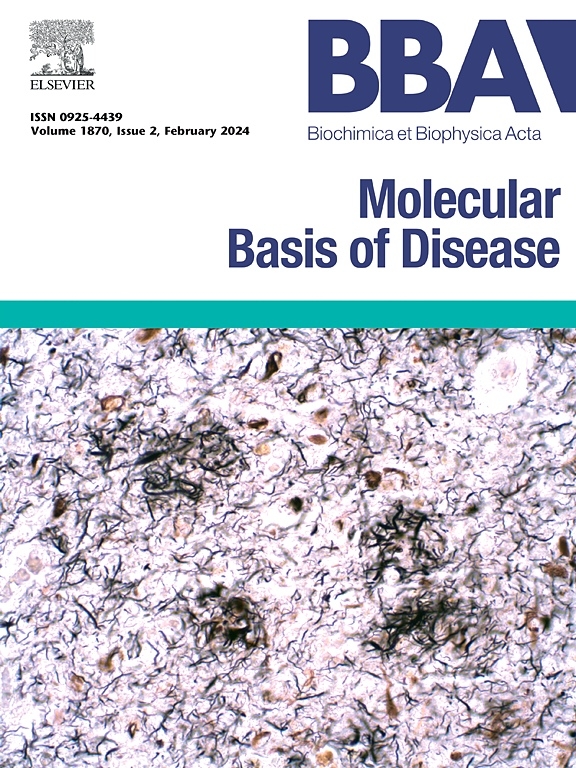细胞外囊泡在神经炎症和神经退行性疾病相互作用中的多方面作用
IF 4.2
2区 生物学
Q2 BIOCHEMISTRY & MOLECULAR BIOLOGY
Biochimica et biophysica acta. Molecular basis of disease
Pub Date : 2025-06-27
DOI:10.1016/j.bbadis.2025.167960
引用次数: 0
摘要
尽管在了解神经退行性疾病的机制方面取得了进展,但有效的治疗方法仍然难以捉摸。细胞外囊泡(EVs)是中枢神经系统(CNS)细胞间通讯的关键介质,越来越多地认识到它们参与神经退行性疾病的发病机制,如阿尔茨海默病(AD)、帕金森病(PD)、肌萎缩侧索硬化症(ALS)、多发性硬化症(MS)和亨廷顿病(HD)。体内研究表明,ev在维持中枢神经系统稳态、调节神经炎症反应、影响损伤后组织修复和再生,从而影响疾病进展和恢复方面发挥着至关重要的作用。它们独特的特性,包括小体积和穿越血脑屏障(BBB)的能力,使它们成为中枢神经系统疾病生物标志物和治疗药物的有希望的候选者。这篇综述深入探讨了神经炎症对神经退行性疾病的重要影响,特别关注了ev的多方面贡献及其与炎症景观的复杂相互作用。我们将探讨EV的生物发生、货物组成、在神经炎症中的多种作用(包括细胞间通讯和神经保护),以及它们作为血脑屏障生物标志物和药物递送载体的潜力,以诊断或治疗神经炎症引起的神经退行性疾病。本文章由计算机程序翻译,如有差异,请以英文原文为准。

Multifaceted roles of extracellular vesicles in the interplay of neuroinflammation and neurodegenerative diseases
Despite advances in understanding neurodegenerative disease mechanisms, effective treatments remain elusive. Extracellular vesicles (EVs), key mediators of intercellular communication within the central nervous system (CNS), are increasingly recognized for their involvement in the pathogenesis of neurodegenerative disorders like Alzheimer's disease (AD), Parkinson's disease (PD), amyotrophic lateral sclerosis (ALS), multiple sclerosis (MS) and Huntington's disease (HD). In vivo studies demonstrate EVs' crucial role in maintaining CNS homeostasis, modulating neuroinflammatory responses, and influencing tissue repair and regeneration following injury, thereby impacting disease progression and recovery. Their unique properties, including small size and ability to cross the blood-brain barrier (BBB), position them as promising candidates for both biomarkers and therapeutics in CNS diseases. This review delves into the significant impact of neuroinflammation on neurodegenerative conditions, specifically focusing on the multifaceted contributions of EVs and their intricate interplay with the inflammatory landscape. We explore EV biogenesis, cargo composition, diverse roles in neuroinflammation (including intercellular communication and neuroprotection), their potential as biomarkers and drug delivery vehicles across the BBB for diagnosis or treatment of neuroinflammation implemented neurodegenerative diseases.
求助全文
通过发布文献求助,成功后即可免费获取论文全文。
去求助
来源期刊
CiteScore
12.30
自引率
0.00%
发文量
218
审稿时长
32 days
期刊介绍:
BBA Molecular Basis of Disease addresses the biochemistry and molecular genetics of disease processes and models of human disease. This journal covers aspects of aging, cancer, metabolic-, neurological-, and immunological-based disease. Manuscripts focused on using animal models to elucidate biochemical and mechanistic insight in each of these conditions, are particularly encouraged. Manuscripts should emphasize the underlying mechanisms of disease pathways and provide novel contributions to the understanding and/or treatment of these disorders. Highly descriptive and method development submissions may be declined without full review. The submission of uninvited reviews to BBA - Molecular Basis of Disease is strongly discouraged, and any such uninvited review should be accompanied by a coverletter outlining the compelling reasons why the review should be considered.

 求助内容:
求助内容: 应助结果提醒方式:
应助结果提醒方式:


